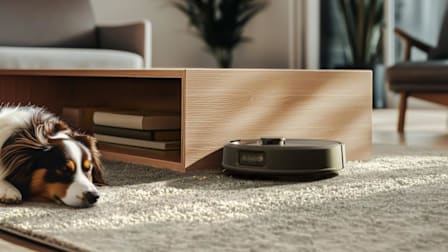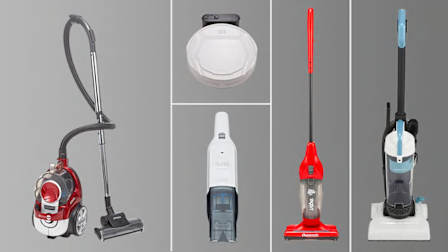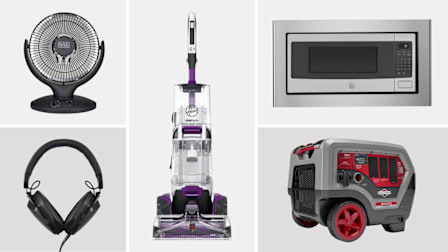Robotic Vacuum Face-Off: iRobot S9+ vs. LG CordZero ThinQ
These two models cost $1,000 or more, but one outperforms the other in CR's tests
When you shop through retailer links on our site, we may earn affiliate commissions. 100% of the fees we collect are used to support our nonprofit mission. Learn more.

You can spend $220 or $1,300 on a robotic vacuum, and while both options might clean well, you’re not likely to get the newest features with cheaper models.
If, on the other hand, you buy a robotic vacuum at the top end of the range, you should expect all the bells and whistles.
Enter the iRobot S9+ and LG CordZero. Both cost more than $1,000 at full price and come with extra features that almost none of the other models in our ratings have, such as a self-emptying dustbin or a real-time camera to show you when and where the vac’s cleaning when you’re not at home.
“Both units also have advanced apps that are constantly being updated and probably a reason they are so expensive,” says Alex Nasrallah, who tests robotic vacuums for Consumer Reports. “They also both offer some interesting features that might make the cost worth it.”
Vitals
iRobot S9+
The iRobot S9+ is 3.5 inches tall, navigates in a grid pattern (as if it were doing laps in a swimming pool and changing lanes every time it hits the wall), and takes roughly 110 minutes to finish a cleaning cycle.
It comes with a self-emptying dustbin, so when your vacuum has finished its journey vacuuming your floors, it automatically releases the debris into a bag at the dock. This model can connect to WiFi, and you can download the iRobot app to see where the bot cleaned during its cycle and to create virtual barriers if you don’t want the robot to clean certain areas.
LG ThinQ
LG’s CordZero ThinQ is 5.8 inches tall, navigates in a grid pattern, and finishes a cleaning cycle in 140 minutes. It connects to WiFi, and you can monitor its cleaning progress with the LG ThinQ smartphone app.
It doesn’t have a self-emptying dustbin, but it does have a large nozzle attached to the front of the robot for more suction area (an unusual addition to a robotic vacuum that no other model in our ratings has) and a camera that can send real-time videos to the ThinQ app as it cleans.
Test by Test
Cleaning: Both the iRobot and the LG get stellar results for cleaning, each earning a Very Good rating in our carpet cleaning tests and an Excellent rating in our bare floors tests.
In our carpet tests, the iRobot scattered some debris around and the LG smeared hair into the carpet, meaning the carpets were not fully clean after the robots were done with them. When it comes to cleaning, it’s a tie between both models.
Navigation: With robotic vacuums, the hope is that you can set them up and let them clean without having to interfere too much. One thing to consider is the height of the robot: The shorter the bot, the more spaces it can successfully roll under to clean.
“The thing that sticks out to me with the LG is that it has a higher profile than the other models we test, so it may not have the same access under furniture as the iRobot,” says Susan Booth, the engineer who oversees vacuum testing at Consumer Reports.
In our navigation tests, the iRobot receives an Excellent rating and the LG receives a Very Good rating—partially because there are areas it can’t navigate because of its height. iRobot emerges from this round as the champ.
Edges: Typically, robotic vacuums have two smaller brushes at the front of the bot that extend outward, allowing them to clean corners as they hug the wall. The iRobot has two rubber side brushes and two square edges, which makes it easier for it to back into corners.
“The LG has a different look from the other models,” Booth says. “The brush roll is in front of the body, almost like a regular vacuum, and that’s unusual for robotic vacuums.”
The LG does not have any side brushes and could not fully reach the corners in our lab setup to clean them thoroughly. In our edge test, the iRobot receives an Excellent rating and the LG a Good rating, which means the iRobot wins this round.
Ease of Use: Both the iRobot and the LG earn the same Very Good rating in our ease-of-use evaluations. Our testers note that the material of the brush rolls make a difference when cleaning hair and other gunk from inside the vacuum.
“The iRobot utilizes two rubber brush rolls, which are more effective and easier to clean than the single plastic brush roll of the LG with nylon bristles,” Nasrallah says.
That’s one blow for the LG, but the iRobot takes a hit, too: It doesn’t come with a remote control, and you must have a smartphone and the app downloaded to be able to control where the robot goes. This one is a tie.
The Winner
The iRobot wins this battle, hands down. Though both vacuums have similar cleaning capabilities, only the iRobot can grab debris at the edges of rooms and maneuver spaces less than 4 inches tall.
You also don’t have to empty the dustbin, and the brush rolls are easier to clean, which means upkeep is less of a challenge.
































